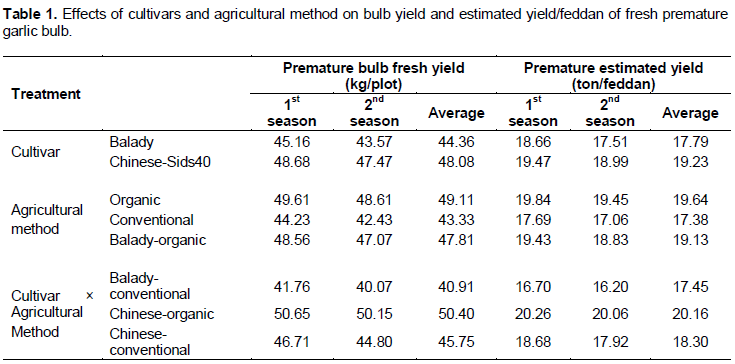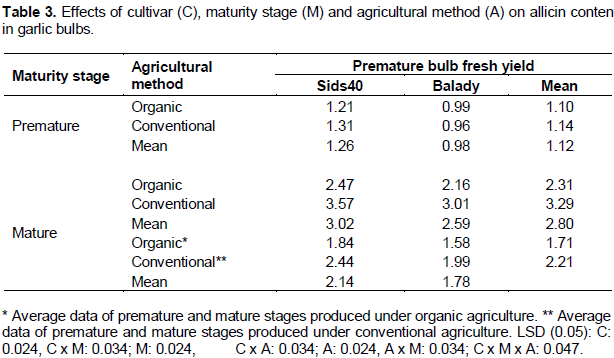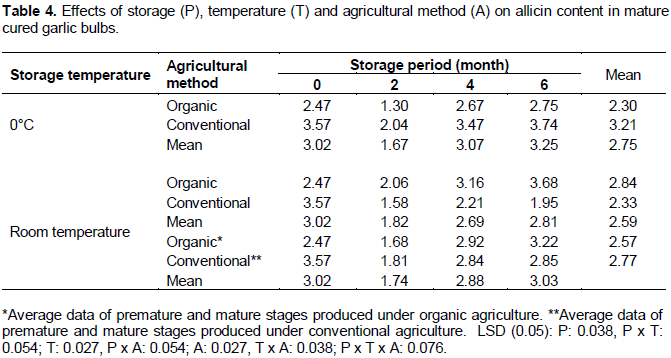ABSTRACT
Balady and Chinese-Sids40 are the main garlic cultivars grown in Egypt. Effect of conventional vs. organic agricultural practices on premature and mature garlic bulb yield was studied for these cultivars. Organic agriculture increased yield of garlic bulbs and was more effective in Balady than in Chinese-Sids40 cultivar. Effect of cultivar type, maturity stage and agricultural methods on allicin content in garlic bulbs was studied using high performance liquid chromatography. Cultivar type and agricultural methods showed more difference in allicin content in cured mature bulb stage than in fresh premature bulb stage. In case of cured mature bulbs, Chinese-Sids40 had higher allicin content (3.02 mg/g FW) than the Balady (2.59 mg/g FW). Effect of storage temperature on allicin content in conventionally- and organically-grown garlic bulbs was studied. Allicin content was higher in organically-grown than conventionally-grown garlic stored at room temperature after six months. At 0°C, allicin content was higher in conventionally-grown than organically-grown garlic. The decrease in allicin content can be explained by the prolonged dormancy period and hindered sprouting that suppressed the metabolic activity.
Key words: Garlic; Allium sativum, Balady, Chinese-Sids40, organic agriculture, allicin, storage.
INTRODUCTION OF ELITE GERMPLASM
Little research has been performed to clarify how different agricultural production methods can affect human health though consumption of food (Woese et al., 1997). Conventional agricultural, using agrochemicals, allowed the world to increase the food production to satisfy the growing human needs. However, extensive abuse of the agrochemicals increased the costs of agricultural production and lead to successive environmental problems causing agricultural un-sustainability. Therefore, there is an increasing interest in organic agriculture using natural fertilizers and biological pest control. During the ten years; 1994-2003, global organic production has increased 20% annually. Currently, the largest global organic producers are Australia, European Union and United States, while the major importers of organic agricultural products are the United States, European Union and Japan (Worthington, 1998). Intake of organic food has some advantages such as intake of higher content of phenolic compounds and some vitamins, and a lower content of nitrates and pesticides (Lima and Vianello, 2011). Garlic (Allium sativum L. (Alliaceae)) is an important crop in Egypt used medicinally for treatment of memory loss, hypertension and microbial infection (AbouZid and Mohamed, 2011). Garlic yield and quality vary greatly with cultivar, location, soil type, agricultural methods and harvest date. The term “biological elasticity” describes garlic’s ability to be adapted to these factors over time. Domestic ecotypes, that are fully adapted to local conditions, are recommended for their usage as initial breeding material (Baghalian et al., 2006). Garlic can be grown successfully on a wide range of soil types. Generally, it grows best on fertile soil. The amount of fertilizers needed vary with the soil type, the amount of organic matter present, the previous crop grown and the climatic conditions during the growing season.
Garlic is sold in markets in two forms; premature garlic (fresh bulbs) and mature garlic (cured bulbs). Mature garlic is harvested when the aerial parts start to wither. It is then subjected to the curing process which means hanging the garlic plant, while the stem and roots are still on, till the outer skins become dry and crispy (Kamenetsky, 2007). The curing helps the neck cells constrict and minimize weight loss through dehydration. Premature garlic bulbs are harvested about one month before mature bulbs harvesting, to ensure the maximum size of bulbs.
This study aimed to investigate the best agronomic conditions to be adopted during garlic production in Egypt. Allicin content was determined in garlic cloves produced using different cultivars, agricultural methods and maturity stages. The effect of storage period and temperature on allicin content in cured mature garlic cloves was also investigated.
Plant material
Two garlic varieties were used in this study; Allium sativum variety sativum (Balady) and variety ophioscordon (Chinese-Sids40). These varieties were identified by Prof. Mamdouh Abdallah, Horticultural Department, Faculty of Agriculture, Ain Shams University, Egypt. Samples were harvested, cured for 21 days and stored in a well-ventilated dry air room away from direct sunlight till extracted.
Effect of agricultural practice
Two field experiments were conducted for two successive seasons 2004/2005 and 2005/2006 at Sids Experimental Research Station, Agricultural Research Centre, Beni-Suef, Egypt. In early September of each season, the field was cleaned, ploughed, leveled and divided into plots (10.5 m2) that contained 5 rows (3.5 m length, 0.6 m width and 70 plants each). Each experiment included four treatments; the two garlic cultivars (Balady and Chinese-Sids40) and the two agricultural practices (conventional and organic). The treatments were arranged in a completely randomized block design with three replicates. Conventional agricultural plots were fertilized with phosphorus, nitrogen and potassium fertilizers. Phosphorus fertilizer was applied using calcium super phosphate (15.5% P2O5) at a rate of 75 kg/feddan (1 feddan = 4200 m²) during soil preparation. Nitrogen fertilizer as applied using ammonium nitrate (33.5% N) at a rate of 100 kg nitrogen/feddan, equally divided after 30 and 60 days from planting. Potassium fertilizer was applied using potassium sulfate (48% K2O) at a rate of 72 kg K2O/feddan equally divided after 30 and 60 days from planting. Organic agricultural plots were fertilized as follows: Phosphorus fertilizer was applied using 250 kg rock phosphate/feddan, nitrogen fertilizer was applied using 70 kg nitrogen/feddan from chicken and farm yard manure (1:3 w/w), potassium fertilizer was applied using 250 kg rock potassium/feddan, and commercial bio-fertilizer was applied using rhizocatertin, phosphorin and potassin at a rate of 3 kg/feddan from each inoculants immediately before planting and one month later. Garlic planting was carried out during the last week of September in both seasons of study. Uniformed cloves were hand-planted on both sides of the ridges at 10 cm apart.
Bulb yield determination
Premature garlic harvesting was done 150 days after planting. At fresh premature garlic harvest date, all plants in the second row of each plot were harvested and cleaned; root and shoot were removed. Fresh bulbs were immediately weighed and converted to record as total yield (kg/plot). Mature garlic harvesting was done one month later, about 180 days after planting, when the aerial parts start to senesce. Marketable yield in the third and fourth rows of each plot were harvested and cured for 3 weeks. The dry root and aerial parts were turned and removed. The cured mature bulbs were weighed in kg and converted to record as total dry yield (kg/plot).
Determination of allicin content
Freshly peeled garlic cloves (2 g) were chopped and blended for one min in 20 ml water. The resulting homogenate was allowed to stand for 5 min at room temperature to ensure maximum production of thiosulfinates. The homogenate was filtered and extracted with chloroform. The chloroform extract was separated, dried over anhydrous sodium sulfate and evaporated at 40°C. The residue was re-dissolved in 3 ml aqueous methanol (50%), filtered through 0.2 μm filter and directly injected into HPLC. The HPLC system consisted of reversed phase (C18), 250 × 2.6 mm, 5 μm particle size column. The mobile phase consisted of methanol:water:formic acid (40:60:0.1) at a flow rate of 1.2 ml/min. The eluate was monitored at a wavelength of 254 nm. Allicin was isolated from garlic extract using preparative silica gel thin layer chromatography using toluene:ethyl acetate (100:30) as developing solvent then identified by spectroscopic data. The resulting spectra were compared with reported data (Cruz-Villalon, 2001; Lawson et al., 1991; Jansen et al., 1987). Pure compound was used to prepare calibration curve.
Effect of storage on allicin content
Random samples, 4 kg of mature bulbs from each plot of Chinese-Sids40 were taken after curing and divided into two samples; one stored at room temperature and the other at 0°C. Allicin content in conventionally-grown and organically-grown cured mature garlic bulbs of Chinese-Sids40 was determined periodically during six months.
Statistical analysis
Bulb yield data were statistically analyzed as a complete randomized block design. A regular analysis of variance was carried according to Snedecor and Cochran (1980). Statistical significance was calculated according to multiple range test of Duncan. Means were compared using the least significant difference test (L.S.D.) at 0.05 level of significance.
Effect of conventional vs. organic agricultural practices on bulb yield for the premature and mature bulbs in Chinese-Sids40 is presented in Tables 1 and 2. Organic agriculture resulted in increasing yield of garlic bulbs. Total fresh bulb yield/plot increased 13.3% in organic over conventional agriculture. This result is in agreement with that reported by Abdallah (2000). Table 1 show that organic agriculture was generally more effective in Balady than in Chinese-Sids40. Balady fresh bulb yield/plot increased 16.9% using organic agriculture over conventional agriculture, compared to 10.2% increase for Chinese-Sids40 as average for the two seasons.


Garlic plant prefers very old manure over chemical fertilizers. This may be explained by the poor and inefficient root system of garlic. Our results are contraindicated with that reported by Dahama (1999) who showed that organic farms give lower yields (1-15%) than conventional farms under sandy soil conditions. The organic concept is: feed the soil, the soil will feed the plant and healthy soil will give healthy plant. Therefore, organic treatment in clay soil conditions, like in Nile valley, provides healthier soil than reclaimed sandy soil. Garlic is characterized by its high content of organosulfur compounds (Lawson, 1996). These compounds are known to have pharmacological activity at doses representing typical levels of garlic consumption. These compounds are categorized under two main groups: γ–glutamyl-S-alk(en)yl cysteines and S-alk(en)yl cysteine sulfoxides (Lawson, 1998).
During sprouting, γ–glutamyl-S-alk(en)yl cysteines are converted by γ–glutamyl transpeptidase enzyme to S-alk(en)yl cysteines which in turn rapidly converted by oxidase enzyme to S-alk(en)yl cysteine sulfoxides. Upon crushing of mature garlic cloves, the cysteine sulfoxides are converted to thiosulfinates (e.g. allicin) by the action of alliinase enzyme (Block et al., 1992). Thiosulfinates are very unstable, self-reacting compounds that give rise to further rearrangements, depending on the temperature, pH and solvent conditions. In order to preserve allicin for routine use as an external standard, it was proposed that the purified compound could be adsorbed on silica gel, and that the adsorbate was stable for 3 months at -24°C (Jansen et al., 1987). However, Jaeger and Koch (1992) reported that silicate adsorbents did not protect the sensitive allicin against its spontaneous decomposition and those preparations, obtained by this way, related to only traces of allicin. The presence of solvents that make hydrogen bonds with the oxygen atom of the thiosulfinate greatly improves their stability, so thiosulfinates are more stable in polar solvents. This explains the high stability of allicin in water compared to hexane, although it is slightly soluble in water (1-2%), moderately soluble in hexane and highly soluble in organic solvents more polar than hexane (Lawson, 1993).
Effect of cultivar type, maturity stage and agricultural methods on allicin content in garlic bulbs was studied using HPLC. Data are shown in Table 3. Significant difference in allicin content was found among the two cultivars and maturity stages studied and agricultural production methods tested. Cultivar type and agricultural methods showed more difference in allicin content in case of cured mature bulb stage than in fresh premature bulb stage. In case of cured mature bulbs, Chinese-Sids40 has higher allicin content (3.02 mg/g FW) than the Balady (2.59 mg/g FW).

Garlic cultivars grown worldwide can be classified within two basic subspecies; A. sativum L. var. ophioscordon (hardneck or topset garlic) and A. sativum L. var. sativum (softneck or artichoke garlic). Hardneck varieties are characterized by large clove size, small number of cloves per bulb and a tall solid flowering scape protruding through the center of the bulb with bulbils at its top. A small proportion of the scape remains with the marketed bulb. Softneck varieties are characterized by small clove size, large number of cloves per bulb and absence of a scape. Lee and Harnely (2005) showed that hardneck garlic (similar to Chinese-Sids40) contains higher alliin content than softneck garlic (similar to Balady). Alliin is responsible for allicin formation once the garlic cloves are crushed. Thiosulfinates content was determined in 34 different garlic varieties, belonging to the major subspecies; softneck and hardneck garlic grown on the same land (Lawson, 1993). No significant difference was found in the levels of allicin or other thiosulfinates between the two subspecies. Only a 1.6 fold range of variation was found among the 34 varieties. However, Camargo et al. (2005) showed that the allicin content can vary significantly between cultivars, keeping constant the variability attributed to the climate conditions and dormancy state of the cloves. Baghalian et al. (2000) reported that there is no significant variation attributed to climatic factors suggesting that there should be an inherent advantage in Iranian-grown garlic. Hardneck garlic was found to have greater methiin, alliin and total free amino acids content compared to softneck garlic, upon comparing the two subspecies for their cysteine sulfoxides and free amino acid content (Lee and Harnly, 2005).
Effect of storage conditions on allicin content in garlic bulbs of Chinese-Sids40 was studied. Results are shown in Table 4. During the dormancy period, the first three months of storage period, allicin content decreased in garlic bulbs stored at room temperature and 0°C. During the next three months, sprouting-initiation period, allicin content started to increase. This may be explained by the suppressed metabolic activity during the dormancy period followed by its promotion during sprouting. Allicin content was higher in organically than conventionally-grown garlic stored at room temperature. On the other hand, allicin content was higher in conventionally than organically-grown garlic stored at 0°C. It is known that the dormancy period is prolonged at low temperature and sprouting is initiated once garlic is taken out of this temperature (Brewester and Radinowitch, 1990). Organically-grown garlic seems to be unable to easily break the prolonged dormancy period, therefore sprouting is somewhat hindered during the first six months of storage at low temperature.

In conclusion, organic agriculture is superior to conventional agriculture in bulb yield and allicin content for fresh premature garlic bulb. Chinese-Sids40 is superior to Balady in bulb yield and allicin content. Organic agriculture improved bulb yield in Balady more than it does in case of Chinese-Sids40. Conventional agriculture showed higher allicin content that organic agriculture in cured mature garlic bulb. Organic agriculture, contrary to conventional agriculture, has shown higher allicin content in garlic bulbs stored at room temperature than that stored at 0°C.
The authors declare no conflicts of interest.
REFERENCES
|
Abdallah MMF (2000). Increasing onion, garlic and carrots yield and quality and controlling weeds by soil solarization. J. Agric. Sci. Mansoura University 25:4611-4625. |
|
|
AbouZid S, Mohamed A (2011). Survey on medicinal plants and spices used in Beni-Sueif, Upper Egypt. J. Ethnobiol. Ethnomed. 7:18-23.
Crossref |
|
|
Baghalian K, Ziai SA, Naghavi MR, Badi HN, Khaligi A (2000). Evaluation of allicin content and botanical traits in Iranian garlic (Allium sativum L.) ecotypes. Sci. Hortic. 103:155-166.
Crossref |
|
|
Baghalian K, Naghavi MR, Ziai SA, Badi HN (2006). Post-planting evaluation of morphological characters and allicin content in Iranian garlic (Allium sativum L.) ecotypes. Sci. Hortic.107:405-410.
Crossref |
|
|
|
Block E, Putman D, Zhao SH (1992). Allium chemistry: GC-MS analysis of thiosulfinates and related compounds from onion, leek, scallion, shallot, chive, and Chinese chive. J. Agric. Food Chem. 40:2431-2438. |
|
|
|
Brewester JL, Radinowitch HD (1990). Onions and allied crops. In: Biochemistry, food science and minor crops. CRC Press 2:265. |
|
|
|
Camargo A, Masuelli RW, Barba JL (2005). Characterization of Argentine garlic cultivars for their allicin content. Acta Hortic. 688:309-312. |
|
|
Cruz-Villalon G (2001). Synthesis of allicin and purification by solid phase extraction. Anal. Biochem. 290:376-378.
Crossref |
|
|
|
Dahama AK (1999). Organic farming; for sustainable agriculture. 2nd Ed. Agrobotanica, India. |
|
|
Jaeger W, Koch HP (1992). Standard allicin adsorbates on silicates. Phytother. Res. 6:149-151.
Crossref |
|
|
Jansen H, Muller B, Knoblock K (1987). Allicin characterization and its determination by HPLC. Planta Med. 53:559-562.
Crossref |
|
|
Kamenetsky R (2007). Garlic: botany and horticulture. Hortic. Rev. 33:123.
Crossref |
|
|
Lawson LD, Wood SG, Hughes BG (1991). HPLC analysis of allicin and other thiosulfinates in garlic clove homogenates. Planta Med. 57:263-270.
Crossref |
|
|
|
Lawson LD (1993). Bioactive organosulfur compounds of garlic and garlic byproducts: role in reducing blood lipids, 306-330. In: Kinghorn A.D., Balandrin, M.F., (eds.). Human medicinal agents from plants, ACS symposium series 534, American Chemical Society, Washington, DC. |
|
|
|
Lawson LD (1996). The composition and chemistry of garlic cloves and processed garlic, In: Koch H.P., Lawson L.D., (eds.). Garlic: the science and therapeutic application of Allium sativum L. and related species. Williams and Wilkins: Baltimore, MD. pp. 37-107. |
|
|
|
Lawson LD (1998). Garlic: a review of its medicinal effects and indicated active compounds, p. 176-209. In: Lawson L.D., Bauer R., (eds.). Phytomedicines of Europe: their chemistry and biological activity. ACS Symposium Series 691, American Chemical Society, Washington, DC. |
|
|
|
Lee J, Harnly JM (2005). Free amino acid and cysteine sulfoxide composition of 11 garlic (Allium sativum L.) cultivars by gas chromatography with flame ionization and mass selective detection. J. Agric. Food Chem. 53:9100-9104. |
|
|
Lima GP, Vianello F (2011). Review on the main differences between organic and conventional plantâ€based foods. Inter. J. Food Sci. Technol. 46(1): 1-13.
Crossref |
|
|
|
Snedecor GW, Cochran WG (1980). Statistical methods. 7th edition, Iowa State University press, Iowa, USA. |
|
|
Woese K, Lange D, Boess C, Bögl KW (1997). Comparison of organically and conventionally grown foods – results of a review of the relevant literature. J. Sci. Food Agric. 74: 281-293.
Crossref |
|
|
|
Worthington V (1998). Effect of agricultural methods on nutritional quality: a comparison of organic with conventional crops. Alt. Ther. Health Med. 4:58-69. |